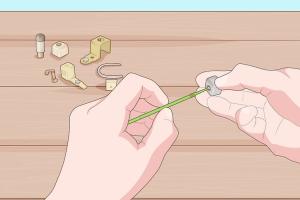Mastering Electrical Maintenance: A Comprehensive Guide to Cleaning Electrical Contacts

-
Quick Links:
- 1. Introduction
- 2. Why Clean Electrical Contacts?
- 3. Tools and Materials Needed
- 4. Step-by-Step Guide to Cleaning Electrical Contacts
- 5. Common Problems and Solutions
- 6. Case Studies
- 7. Expert Insights
- 8. Safety Precautions
- 9. FAQs
1. Introduction
Electrical contacts are integral to the proper functioning of any electrical device. Over time, dirt, oxidation, and wear can hinder their performance, leading to device malfunction or failure. In this comprehensive guide, we will explore effective methods for cleaning electrical contacts, ensuring your devices function optimally.
2. Why Clean Electrical Contacts?
Cleaning electrical contacts is crucial for several reasons:
- Performance Improvement: Clean contacts ensure better connectivity, reducing resistance and enhancing electrical flow.
- Longevity: Regular maintenance can prolong the lifespan of your devices, saving you money on replacements.
- Safety: Dirty contacts can lead to overheating and electrical fires; proper cleaning minimizes these risks.
3. Tools and Materials Needed
Before starting the cleaning process, gather the following tools and materials:
- Contact cleaner solution (isopropyl alcohol or specialized contact cleaner)
- Soft cloth or lint-free wipes
- Small brushes (like toothbrushes or paintbrushes)
- Safety goggles and gloves
- Multimeter (for testing conductivity)
4. Step-by-Step Guide to Cleaning Electrical Contacts
Follow these detailed steps for effective cleaning:
Step 1: Disconnect Power
Before you begin, ensure that all power sources are disconnected. This is crucial for your safety and to prevent damage to the device.
Step 2: Inspect the Contacts
Visually inspect the electrical contacts for signs of corrosion, dirt, or wear. This will help you determine the extent of cleaning required.
Step 3: Apply Contact Cleaner
Spray the contact cleaner onto the affected area. If using isopropyl alcohol, apply it to a cloth first, then wipe the contacts.
Step 4: Scrub Gently
Using a soft brush, gently scrub the contacts to remove any buildup. Avoid using excessive force, which may damage the contacts.
Step 5: Wipe Away Residue
After scrubbing, use a clean cloth to wipe away any remaining cleaner and debris. Ensure that the contacts are dry before reassembly.
Step 6: Test for Conductivity
Once everything is clean and dry, reconnect the power and use a multimeter to test for proper conductivity. This step is essential to ensure the effectiveness of your cleaning.
5. Common Problems and Solutions
During the cleaning process, you may encounter common issues. Here are some solutions:
- Persistent Corrosion: If corrosion remains after cleaning, consider using a specialized corrosion remover or consult a professional.
- Pitting or Damage: If contacts are pitted, replacement may be necessary.
6. Case Studies
Here are a few real-world examples demonstrating the importance of cleaning electrical contacts:
Example 1: Automotive Electrical System
A car owner noticed intermittent starting issues. After cleaning the starter motor contacts, the problem was resolved, highlighting the importance of regular maintenance.
Example 2: Home Appliances
A refrigerator that frequently cycles on and off was found to have dirty compressor contacts. Cleaning restored its functionality and efficiency.
7. Expert Insights
We consulted electrical engineers to gather insights on best practices for maintaining electrical contacts:
"Regular inspection and cleaning of electrical contacts can prevent costly repairs and enhance device reliability." - John Smith, Electrical Engineer
8. Safety Precautions
Always follow these safety precautions while cleaning electrical contacts:
- Wear protective gloves and goggles.
- Ensure the environment is well-ventilated when using chemical cleaners.
- Never work on live circuits.
9. FAQs
1. How often should I clean electrical contacts?
It's recommended to clean electrical contacts at least once a year or whenever you notice performance issues.
2. Can I use water to clean electrical contacts?
No, water can cause corrosion. Use specialized contact cleaners instead.
3. What should I do if cleaning doesn't solve the problem?
If issues persist, you may need to replace the contacts or consult a professional.
4. Is it safe to clean contacts in appliances?
Yes, as long as the power is disconnected and proper safety measures are taken.
5. Can I clean contacts with a cloth only?
While a cloth can help, using a contact cleaner is more effective in removing grime and oxidation.
6. What types of contact cleaners are available?
There are various types, including isopropyl alcohol, specialized electrical contact cleaners, and degreasers.
7. How do I know if my contacts need cleaning?
Look for signs of corrosion, inconsistent performance, or visible dirt on the contacts.
8. Can I use a toothbrush to clean contacts?
Yes, a soft toothbrush is effective for scrubbing without damaging the contacts.
9. Are there any risks in cleaning electrical contacts?
Risks include electrical shock and damage to components if proper precautions aren't taken.
10. Is contact cleaning a DIY task?
Yes, most contact cleaning can be done safely as a DIY task with the right tools and precautions.
Random Reads
- How to install apps from app store ipad
- How to hang a shower curtain rod
- How to find out why you were suspended on xbox live
- How to install deb files linux
- How to install download powerpoint
- Unlocking convenience apple wallet iphone
- How to determine the correlation coefficient
- How to get to high hrothgar in skyrim
- How to make degree symbol
- How to make cool stuff in minecraft